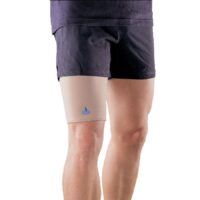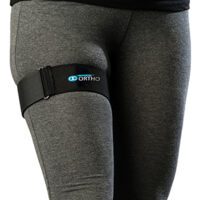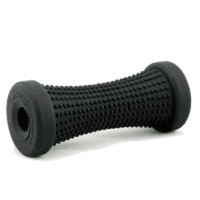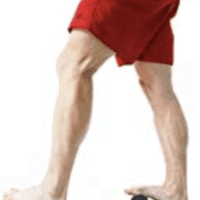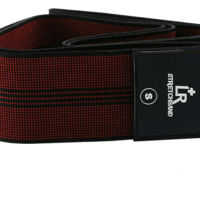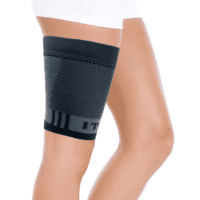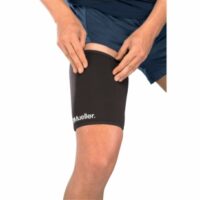Thigh Strain
Article by John Miller

Thigh Strain
Quadriceps Strain, Pulled Thigh Muscle
What is a Thigh Strain?
A thigh strain, a quadriceps strain or pulled thigh muscle is an injury when the muscles in the front of your thigh overstretch. The result is a minor or severe tear in the muscle fibres. Your thigh has three main muscle groups: the quadriceps at the front, the hamstrings at the back, and the adductors on the inner side. The ITB (Iliotibial Band) is the main component of the outside of your thigh.
What Causes a Thigh Strain?
Several factors increase your risk of a thigh strain, including tight muscles, muscle fatigue, muscle imbalances, incorrect exercise techniques, inadequate warm-up before exercising, and incomplete healing of a previous thigh strain.
- Tight muscles
- Muscle fatigue
- Muscle imbalances
- Incorrect exercise techniques
- Inadequate warm-up before exercising
- Insufficient healing of a previous thigh strain
What are the Symptoms of a Thigh Strain?
The symptoms of a thigh strain can manifest in the following ways:
- You may experience pain or discomfort while engaging in activities that involve the affected thigh muscle, such as walking, climbing stairs, standing up, or kicking.
- When you stretch the affected muscle, there may be a pulling or tugging sensation, such as attempting to bring your heel to your bottom.
- The thigh area may exhibit tenderness, swelling, or bruising.
- At the moment of injury, you may hear an audible “pop” or “snap,” indicating a significant tear or rupture in the muscle fibres.
How is a Thigh Strain Diagnosed?
To diagnose a thigh strain, a healthcare provider, such as a physiotherapist, will:
- Conduct a physical examination and review your medical history.
- Look for signs of a thigh strain during the physical examination, including checking for tenderness, swelling, or bruising in the affected area.
- Request you to perform specific movements to assess pain or weakness.
In some instances, additional diagnostic tests like an ultrasound or MRI may be necessary to confirm the location and severity of the injury. An ultrasound employs high-frequency sound waves to generate images of the muscles and soft tissues. At the same time, an MRI utilises a strong magnetic field and radio waves to produce detailed images of the internal structures of your thigh.
What is the Treatment for a Thigh Strain?
The treatment for a thigh strain includes Physiotherapy:
- Your healthcare provider may recommend rest, ice, compression, and elevation (RICE) initially to alleviate pain and reduce swelling.
- Manual therapy techniques, like massage or mobilisation, may be employed by your physiotherapist to reduce muscle tension and enhance joint mobility.
- Your physiotherapist may advise using crutches, depending on the severity of the injury, to protect the injured leg and minimise weight-bearing.
- Your physiotherapist will design a customised exercise program to strengthen your thigh muscles, incorporating exercises, e.g. leg presses, squats, and lunges. They may include balance and coordination exercises like single-leg stance and agility drills.
- Your physiotherapist may utilise modalities such as ultrasound, dry needling, or taping to manage pain and aid in the healing process.
- Your physiotherapist will adjust your rehabilitation program as you progress, modifying exercises and gradually increasing intensity to facilitate your return to your previous level of function and activity.
How to Prevent a Thigh Strain?
To prevent a thigh strain, you can take the following proactive measures:
- Warm up and stretch: Engage in a proper warm-up routine and perform dynamic stretching exercises to prepare your muscles for activity and prevent muscle tightness. Spend 5-10 minutes engaging in low-intensity exercises like jogging or cycling, followed by specific stretches targeting your thigh muscles.
- Gradually progress: Incrementally increase your workouts’ intensity, duration, and frequency. Avoid sudden spikes in exercise load, leading to muscle fatigue and increasing the risk of injury.
- Focus on technique and form: Pay attention to your athletic performance and maintain proper form and technique. Incorrect biomechanics can strain your muscles unnecessarily and elevate the risk of injury.
- Incorporate leg massages: Regular massages can help alleviate muscle tightness, enhance blood circulation, and improve muscle flexibility.
- Commit to rehabilitation programs: If you have previously experienced a thigh strain, complete your entire rehabilitation program to prevent re-injury and promote recovery. These preventative measures can mitigate the risk of developing a thigh strain and maintain strong and healthy muscles.
Return to Sport with a Thigh Strain?
Before returning to your sport after a thigh strain, it is advisable to consult a sports physiotherapist for professional guidance. They will assess your injury, monitor your rehabilitation progress, and offer tailored guidelines to prevent re-injury.
Returning to a sport prematurely or without the proper rehabilitation can result in additional damage and hinder your recovery. Therefore, it is crucial to exercise caution and seek professional advice. Please consult a trusted physiotherapist for personalised recommendations regarding returning to sport after a thigh strain.
Rochedale - Call 38410277
Book Online: RochedaleSalisbury - Call 32751044
Book Online: SalisburySandgate - Call 32691122
Book Online: SandgateRelated Articles
- Thigh Pain – Offers comprehensive information on the causes, symptoms, and treatment options for different thigh injuries, including thigh strains. This article is a great resource for understanding the broader context of thigh injuries.
- Proximal Hamstring Tendinopathy – Focuses on a specific type of thigh injury related to the hamstring, providing details on symptoms, causes, and treatment strategies. It’s particularly relevant for readers experiencing pain at the back of the thigh.
- Corked Thigh – Explains symptoms, treatments, and recovery tips for a corked thigh, which is another common thigh injury that can occur alongside or independently of thigh strains.
- Hamstring Strain – Provides in-depth insights into hamstring strains, a closely related condition that affects the back of the thigh. It includes information on symptoms, prevention, and rehabilitation exercises.
- Gluteal Tendinopathy – Though focused on the gluteal tendons, this article is relevant for individuals experiencing lateral hip and thigh pain. It discusses symptoms, causes, and treatment for tendinopathy, which can be related to or affect recovery from a thigh strain.








